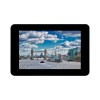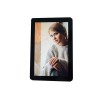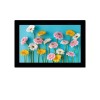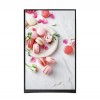Products
Hot Product
1.3inch IPS 240*240 square lcd screen module
Product advantages: square,full viewing display, high brightness display, ultra-thin display.
LCM Model: R13004-240240SZ-QT
LCD Size:1.3inch
LCD Resolution: 240*240
LCM IC: ST7789V2
LCM Interface:4Line SPI
LCM OD: 26.17x29.22x1.5mm
LCD AA: 23.4x23.4mm
Display viewing angle: IPS
Display brightness: 240/350/500nit
Touch Screen: with or without touch
1.3 inch 240x240 TFT LCD display parameters:
|
Item |
Specification |
Unit |
|
LCD screen size |
1.3 |
inch |
|
Display Mode |
Normally Black |
-- |
|
Resolution |
240x(RGB)x240 |
Pixel |
|
Pixelarrangement |
RGB Vertical Stripe |
|
|
Viewingangle |
Full Viewing(IPS) |
- |
|
Module outline dimension |
26.17(H)x29.22(V)x1.5(T) |
mm |
|
LCD AA |
23.4(H)*23.4(V) |
mm |
|
DisplayColors |
262k |
colors |
|
Driver IC |
ST7789V2 |
- |
|
LCDInterface |
4 Line-SPI |
-- |
|
Luminance |
240(TPY) |
cd/㎡ |
|
Backlight Arrangement |
White LED(1S2P) |
-- |
|
Touch IC |
CST816D |
-- |
|
Touch point |
Single Point |
-- |
|
Touch structure |
GF |
-- |
|
Touch Interface |
IIC |
-- |
|
Cover lens |
Glass T=1.0 |
mm |
|
Surface hardness |
6H |
-- |
|
Cover lensColors |
Black |
-- |
|
Weight (LCM/TP+LCM) |
TBD |
g |
|
Operating Temperature |
-20℃~ +70℃ |
Deg.c |
|
Storage Temperature |
-30℃~ +80℃ |
Deg.c |


Which is better TFT or LCD?
LCD stands for Liquid Crystal Display, a technology that uses liquid crystals combined with polarizers to display images. It’s a versatile technology found in everything from televisions to smartphones to digital clocks.
LCD screens are known for their ability to produce clear and sharp images with relatively low power consumption. They work by manipulating light, which passes through liquid crystals and is then filtered to create images on the screen.
TFT, or Thin-Film Transistor, is a specific type of LCD technology. It’s an active matrix display, meaning it uses transistors to control each pixel's brightness, providing faster refresh rates and better control over the display. TFT screens are widely used in devices like smartphones, tablets, and monitors.
1. Image Quality
TFT: Generally offers better image quality due to its active matrix structure. Colors are more vibrant, and the response time is faster, which is essential for activities like gaming or watching fast-paced videos.LCD: While still good, standard LCD screens without TFT technology might not offer the same level of color accuracy or response time. However, they are still more than adequate for everyday tasks like browsing or document editing.
2. Viewing Angles
TFT: Tends to have narrower viewing angles. When viewed from the side, colors can appear washed out or distorted.LCD: Typically provides wider viewing angles, making it a better choice for group viewing or scenarios where the screen will be seen from multiple perspectives.
3. Power Consumption
TFT: Consumes more power than standard LCD screens due to the active matrix technology. This can lead to shorter battery life in portable devices.LCD: More energy-efficient, making it a better option for devices where battery life is a priority.
4. Cost
TFT: Generally more expensive due to its advanced technology and better performance characteristics.LCD: Usually more affordable, making it a cost-effective option for those on a budget.
5. Applications
TFT: Ideal for devices requiring high-performance displays, such as gaming monitors, smartphones, and high-end laptops.LCD: Perfect for devices where high performance is not as critical, such as basic monitors, calculators, or digital clocks.
So, Which is Better?
The answer depends largely on your needs. If you prioritize image quality, performance, and don’t mind spending a bit more, then TFT is likely the better choice for you. However, if you’re looking for a more affordable, energy-efficient option with decent performance, then a LCD Screen will serve you well.
1.3 inch lcd module outline 240xRGBx240 with SPI interface:














